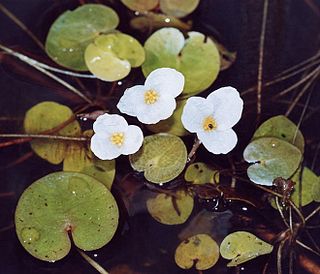
Hydrocharitaceae is a flowering plant family including 16 known genera with a total of ca 135 known species, that including a number of species of aquatic plant, for instance the tape-grasses, the well known Canadian waterweed, and frogbit.
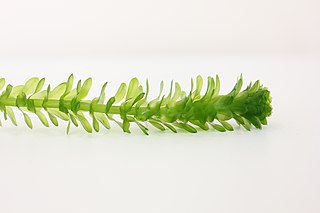
Egeria is a genus of three species of aquatic plants in the family Hydrocharitaceae described as a genus in 1849. native to warm-temperate South America.
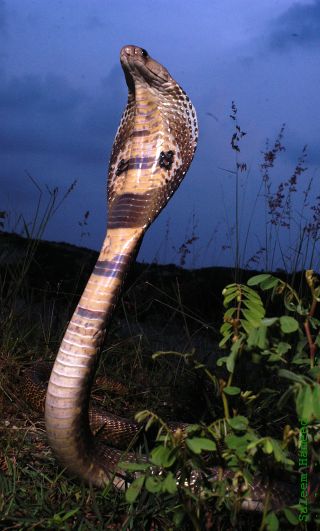
The Indian cobra, also known commonly as the spectacled cobra, Asian cobra, or binocellate cobra, is a species of cobra, a venomous snake in the family Elapidae. The species is native to the Indian subcontinent, and is a member of the "big four" species that are responsible for the most snakebite cases in India.

Najas, the water-nymphs or naiads, is a genus of aquatic plants. It is cosmopolitan in distribution, first described for modern science by Linnaeus in 1753. Until 1997, it was rarely placed in the Hydrocharitaceae, and was often taken as constituting the family Najadaceae.

Najas minor, known as brittle naiad or brittle waternymph, is an annual aquatic plant, a submersed herb. It is native to Europe, Asia and North Africa from the Netherlands to Morocco east to Japan and the Philippines, including China, Siberia, Central Asia, Iran, Turkey, Ukraine, Germany, France Italy and a host of other countries. It is now introduced to North America and considered a weedy invasive species in the eastern half of the United States from Florida to Oklahoma to New Hampshire to Ontario to South Dakota. This plant prefers calm waters, such as ponds, reservoirs, and lakes, and is capable of growing in depths up to 4 meters.
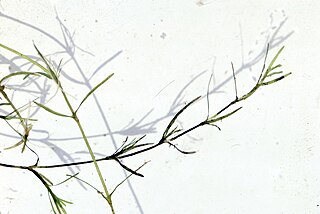
Najas flexilis is an aquatic annual plant native to parts of North America and Europe. It is native to northern and central Europe from Norway to Ireland to Switzerland, and from there across Russia. It is also considered native throughout most of Canada, and the northern United States in disjunct populations in southern California, Arizona, Missouri, South Carolina and Utah. Its common names include slender naiad and nodding waternymph.

Lemna trisulca L. is a species of aquatic plants in the arum family Araceae. It has a subcosmopolitan distribution. Unlike other duckweeds, it has submerged rather than floating fronds, except when flowering or fruiting. Also unlike other duckweeds, a large number of fronds remain attached to each other at a time.

Najas guadalupensis is a species of aquatic plant known by the common names southern waternymph, guppy grass, najas grass, and common water nymph. It is native to the Americas, where it is widespread. It is considered native to Canada, and most of the contiguous United States, Mexico, Central America, the West Indies and South America. It has been introduced in Japan, Israel and Palestine.

Najas marina is a species of aquatic plant known by the common names spiny water nymph, spiny naiad and holly-leaved naiad. It is an extremely widespread species, reported across Europe, Asia, Africa, Australia, the Americas and many oceanic islands. It can be found in many types of freshwater and brackish aquatic habitat, including bodies of alkaline water.
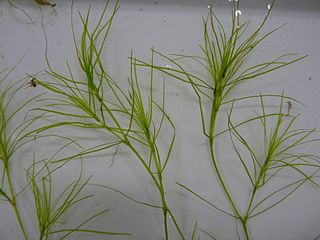
Najas graminea, also known as ricefield water-nymph is a species of aquatic plant found in freshwater habitats, especially still or slow-moving waters, like ponds and rice fields. It grows to a maximum length of 30 cm. The flowers are monoecious. The flowering season is from July to September.</ref>

Aponogeton natans is a species of aquatic plant in the family Aponogetonaceae.
Najas filifolia, the needleleaf waternymph, is an aquatic plant in the Hydrocharitaceae. It is a rare and little-known species, known from only three counties (Decatur County, Georgia; Santa Rosa County, Florida; and Leon County, Florida. It is unusual in the genus in bearing fruits that are recurved to crescent-shaped.
Najas wrightiana is a species of aquatic plant in the Hydrocharitaceae family. It is referred to by the common name Wright's waternymph, and is found in lakes and streams. It is native to Mexico, Guatemala, Belize, Honduras, the Bahamas, Cuba, and Venezuela. It is also considered introduced and naturalized in southern Florida.

Najas gracillima, the slender waternymph, is a submerged species of aquatic plant in the Hydrocharitaceae family. found in lakes and streams. It is native to China, Russian Far East, Japan, Korea, Taiwan, Iran, Alberta, Ontario, Newfoundland, Nova Scotia, New Brunswick, the eastern United States. It is also considered introduced and naturalized in France, Spain, Italy and California.
Najas pseudogracillima, called the Hong Kong water nymph, is an aquatic plant growing in fresh water ponds. It is a rare and little-known species known from one collection from a pond on the campus of Chung Chi College at the Chinese University of Hong Kong. It is very similar to N. gracillima except that the male inflorescences lack a spathe.
Najas kurziana, called the Bihar water nymph, is an aquatic plant growing in fresh water ponds. It is a rare and little-known species known from East Timor and from the State of Bihar in India. The species was initially discovered between Kishenganj and Oolabena, near the border with Nepal.
Najas ancistrocarpa is a species of aquatic plant in the Hydrocharitaceae family. It grows in fresh water ponds and is a native to Japan (Honshu) and to parts of China.
Najas tenuifolia is an aquatic plant growing in fresh water ponds. It is a native to Hong Kong, Thailand, Indonesia, the Philippines and Australia.

Najas tenuis is a species of aquatic plant found in freshwater habitats, especially still or slow-moving waters, like ponds and rice fields.













